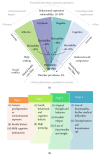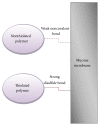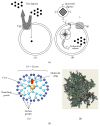Bypassing P-Glycoprotein Drug Efflux Mechanisms: Possible Applications in Pharmacoresistant Schizophrenia Therapy
- PMID: 26491671
- PMCID: PMC4600488
- DOI: 10.1155/2015/484963
Bypassing P-Glycoprotein Drug Efflux Mechanisms: Possible Applications in Pharmacoresistant Schizophrenia Therapy
Abstract
The efficient noninvasive treatment of neurodegenerative disorders is often constrained by reduced permeation of therapeutic agents into the central nervous system (CNS). A vast majority of bioactive agents do not readily permeate into the brain tissue due to the existence of the blood-brain barrier (BBB) and the associated P-glycoprotein efflux transporter. The overexpression of the MDR1 P-glycoprotein has been related to the occurrence of multidrug resistance in CNS diseases. Various research outputs have focused on overcoming the P-glycoprotein drug efflux transporter, which mainly involve its inhibition or bypassing mechanisms. Studies into neurodegenerative disorders have shown that the P-glycoprotein efflux transporter plays a vital role in the progression of schizophrenia, with a noted increase in P-glycoprotein function among schizophrenic patients, thereby reducing therapeutic outcomes. In this review, we address the hypothesis that methods employed in overcoming P-glycoprotein in cancer and other disease states at the level of the BBB and intestine may be applied to schizophrenia drug delivery system design to improve clinical efficiency of drug therapies. In addition, the current review explores polymers and drug delivery systems capable of P-gp inhibition and modulation.
Figures









Similar articles
-
Differential pharmacological regulation of drug efflux and pharmacoresistant schizophrenia.Bioessays. 2008 Feb;30(2):183-8. doi: 10.1002/bies.20706. Bioessays. 2008. PMID: 18200566 Review.
-
Regional increase in P-glycoprotein function in the blood-brain barrier of patients with chronic schizophrenia: a PET study with [(11)C]verapamil as a probe for P-glycoprotein function.Psychiatry Res. 2010 Aug 30;183(2):151-6. doi: 10.1016/j.pscychresns.2010.05.002. Psychiatry Res. 2010. PMID: 20620031
-
A pilot study on brain-to-plasma partition of 10,11-dyhydro-10-hydroxy-5H-dibenzo(b,f)azepine-5-carboxamide and MDR1 brain expression in epilepsy patients not responding to oxcarbazepine.Epilepsia. 2005 Oct;46(10):1613-9. doi: 10.1111/j.1528-1167.2005.00265.x. Epilepsia. 2005. PMID: 16190932
-
Blood-brain barrier transport of naloxone does not involve P-glycoprotein-mediated efflux.J Pharm Sci. 2010 Jan;99(1):413-21. doi: 10.1002/jps.21819. J Pharm Sci. 2010. PMID: 19530072
-
Molecular and functional characterization of P-glycoprotein in vitro.Methods Mol Biol. 2011;686:313-36. doi: 10.1007/978-1-60761-938-3_15. Methods Mol Biol. 2011. PMID: 21082379 Review.
Cited by
-
Basic physiology of the blood-brain barrier in health and disease: a brief overview.Tissue Barriers. 2021 Jan 2;9(1):1840913. doi: 10.1080/21688370.2020.1840913. Epub 2020 Nov 15. Tissue Barriers. 2021. PMID: 33190576 Free PMC article. Review.
-
Paliperidone, a relatively novel atypical antipsychotic drug, is a substrate for breast cancer resistance protein.Exp Ther Med. 2018 Dec;16(6):5410-5416. doi: 10.3892/etm.2018.6847. Epub 2018 Oct 11. Exp Ther Med. 2018. PMID: 30542502 Free PMC article.
-
Multiple extreme overdose of antipsychotics with minimal side effects: A case report.Clin Case Rep. 2024 May 3;12(5):e8852. doi: 10.1002/ccr3.8852. eCollection 2024 May. Clin Case Rep. 2024. PMID: 38707604 Free PMC article.
-
Molecular Mechanism of Matrine from Sophora alopecuroides in the Reversing Effect of Multi-Anticancer Drug Resistance in K562/ADR Cells.Biomed Res Int. 2019 Nov 22;2019:1269532. doi: 10.1155/2019/1269532. eCollection 2019. Biomed Res Int. 2019. PMID: 31871929 Free PMC article.
-
Diagnostic and therapeutic agents that target alpha-synuclein in Parkinson's disease.J Neurol. 2022 Nov;269(11):5762-5786. doi: 10.1007/s00415-022-11267-9. Epub 2022 Jul 13. J Neurol. 2022. PMID: 35831620 Free PMC article. Review.
References
Publication types
MeSH terms
Substances
LinkOut - more resources
Full Text Sources
Other Literature Sources
Medical
Miscellaneous

